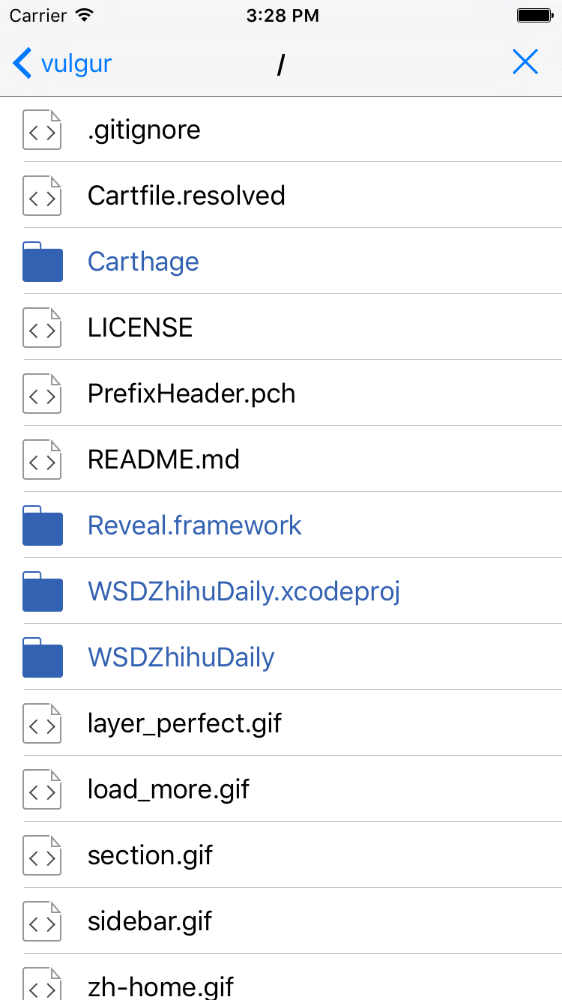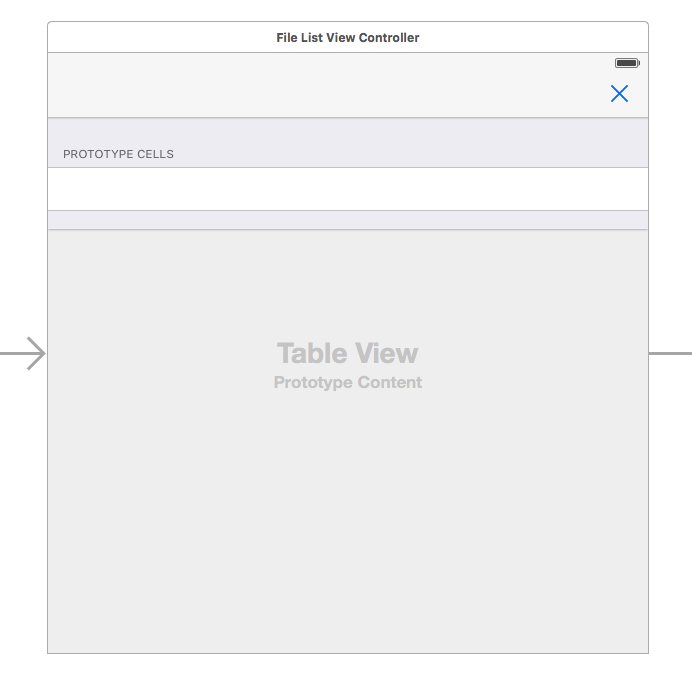Sources 开发日记四 (文件列表页面)
Code Reader 改名为 Sources
1.0 也已经上架,App Store: http://itunes.apple.com/app/id1125732186 。
同时 Sources 也在 Github 上开源了,地址是: https://github.com/vulgur/Sources 。
这篇讲讲 Repo 的文件列表的页面。这部分的功能包括显示文件列表,根据文件类型显示不同的图标以及进行相应的选择处理。

View
这个页面就是一个简单的 UITableView,所以在 Storyboard 中就选择了 Table View Controller。每一个 Cell 就是一个文件(或目录),点击目录的话进入子目录的文件列表页面,点击文件的话就进入代码页面。因为不能像电脑上通过树形视图来浏览文件目录结构,如果目录层次太深的话想返回到 Repo 页面就会令人十分抓狂(比如 Java 项目,无穷无尽的包目录啊),我在右上角添加了一个 Bar Button Item,用来一键返回到 Repo 页面。

File Cell 也是自定义的,布局十分简单,就是左面是图标,右面是文件名,这里就不贴图和代码了。
Model
每个 Cell 对应的 model 就是 RepoFile ,这是根据 Github API 定义的类。
import ObjectMapper
class RepoFile: Mappable {
var name: String?
var type: String?
var path: String?
var downloadURLString: String?
var htmlURLString: String?
var apiURLString: String?
required init?(_ map: Map) {
}
func mapping(map: Map) {
name <- map["name"]
type <- map["type"]
path <- map["path"]
downloadURLString <- map["download_url"]
htmlURLString <- map["html_url"]
apiURLString <- map["url"]
}
}
这个类在以后的 blog 中还会用到,而且还需要改动,这里的代码是只满足本篇的版本。
Controller
负责 model 和 view 背后工作的就是 FileListViewController 。
获取文件列表数据
这个 controller 有一个属性 apiURLString ,是由 UINavigationController 中上一级的 controller 传入的,每个文件列表就是根据这个字符串通过 Github API 来获取文件数据的。
func fetchFileList(path: String) {
EZLoadingActivity.show("loading files", disableUI: true)
Alamofire.request(.GET, path)
.responseJSON { (response) in
switch response.result{
case .Success:
if let items = Mapper<RepoFile>().mapArray(response.result.value) {
self.fileList = items
self.tableView.reloadData()
}
case .Failure(let error):
print(error)
}
EZLoadingActivity.hide()
}
}
显示文件和目录
RepoFile 有一个属性是 type ,代表文件的类型,file 或 dir。在配置 cell 的时候,根据这个属性来设置 cell 的样式。
override func tableView(tableView: UITableView, cellForRowAtIndexPath indexPath: NSIndexPath) -> UITableViewCell {
let cell = tableView.dequeueReusableCellWithIdentifier("FileCell", forIndexPath: indexPath) as! FileCell
let file = fileList[indexPath.row]
if file.type == "dir" {
cell.filenameLabel.textColor = UIColor(red: 51/255, green: 98/255, blue: 178/255, alpha: 1)
cell.fileIconImageView.image = UIImage(named: "dir")
} else {
cell.fileIconImageView.image = UIImage(named: "file")
}
cell.filenameLabel.text = file.name
return cell
}
根据文件类型选择不同的操作
前面说了,要区分对不同文件类型的点击操作。点击 file 文件就很简单,直接跳转到展示代码的页面,这个下一篇 blog 会讲。点击 dir 文件就要 push 一个 FileListViewController ,这里需要用从 UIStoryboard 中新建,而不能直接初始化 FileListViewController ,因为一来直接初始化得来的实例没有右上角那个 Bar Button Item,二来这个实例也没有 storyboard 中建立的那些 segue。
override func tableView(tableView: UITableView, didSelectRowAtIndexPath indexPath: NSIndexPath) {
let file = fileList[indexPath.row]
if file.type == "dir" {
let nextFileListVC = UIStoryboard(name: "Main", bundle: nil).instantiateViewControllerWithIdentifier("FileListViewController") as! FileListViewController
nextFileListVC.apiURLString = file.apiURLString
if pathTitle == "/" {
nextFileListVC.pathTitle = self.pathTitle + file.name!
} else {
nextFileListVC.pathTitle = self.pathTitle + "/" + file.name!
}
navigationController?.pushViewController(nextFileListVC, animated: true)
} else if file.type == "file" {
performSegueWithIdentifier("ShowCode", sender: file)
}
}
override func prepareForSegue(segue: UIStoryboardSegue, sender: AnyObject?) {
if segue.identifier == "ShowCode" {
let codeVC = segue.destinationViewController as! CodeViewController
let file = sender as! RepoFile
RecentsManager.sharedManager.addRecentFile(file)
codeVC.filename = file.name
codeVC.downloadAPI = file.downloadURLString
}
}
返回到 Repo 页面
终于讲到这个功能,这是我灵机一动想出来的,觉得还是十分实用的。
实现也十分简单,从 storyboard 中拉一个 IBAction 到 controller 中,pop 到 RepoViewController 就可以。
@IBAction func backToRoot(sender: UIBarButtonItem) {
if let repoVC = navigationController?.viewControllers[1] {
navigationController?.popToViewController(repoVC, animated: true)
} else {
navigationController?.popToRootViewControllerAnimated(true)
}
}
优化路径显示
导航栏的标题显示的是当前目录的路径,但是如果路径太长的话(很常见)iOS 就会截断这个字符串,导致信息不完整。所以我做了两个小事情:
- 优化返回按钮的 title。如果当前页面是根目录,这个 title 显示的是 repo 的名字;如果是第二级目录,则显示 “/”;其他子目录就显示父目录的名字。
- 导航栏的标题在长度允许的情况下,显示完整路径,否则只显示父目录和本目录,父目录以上的路径用“…”代替。
func configNavigationTitle() {
let pathComponents = self.pathTitle.componentsSeparatedByString("/")
let currentPath = pathComponents[pathComponents.count-1]
let parentPath = pathComponents[pathComponents.count-2]
navigationItem.backBarButtonItem = UIBarButtonItem(title: currentPath == "" ? "/" : currentPath, style: UIBarButtonItemStyle.Plain, target: nil, action: nil)
if pathTitle.characters.count > 30 {
navigationItem.title = ".../" + parentPath + "/" + currentPath
} else {
navigationItem.title = pathTitle
}
}











![[HBLOG]公众号](https://www.liuhaihua.cn/img/qrcode_gzh.jpg)

